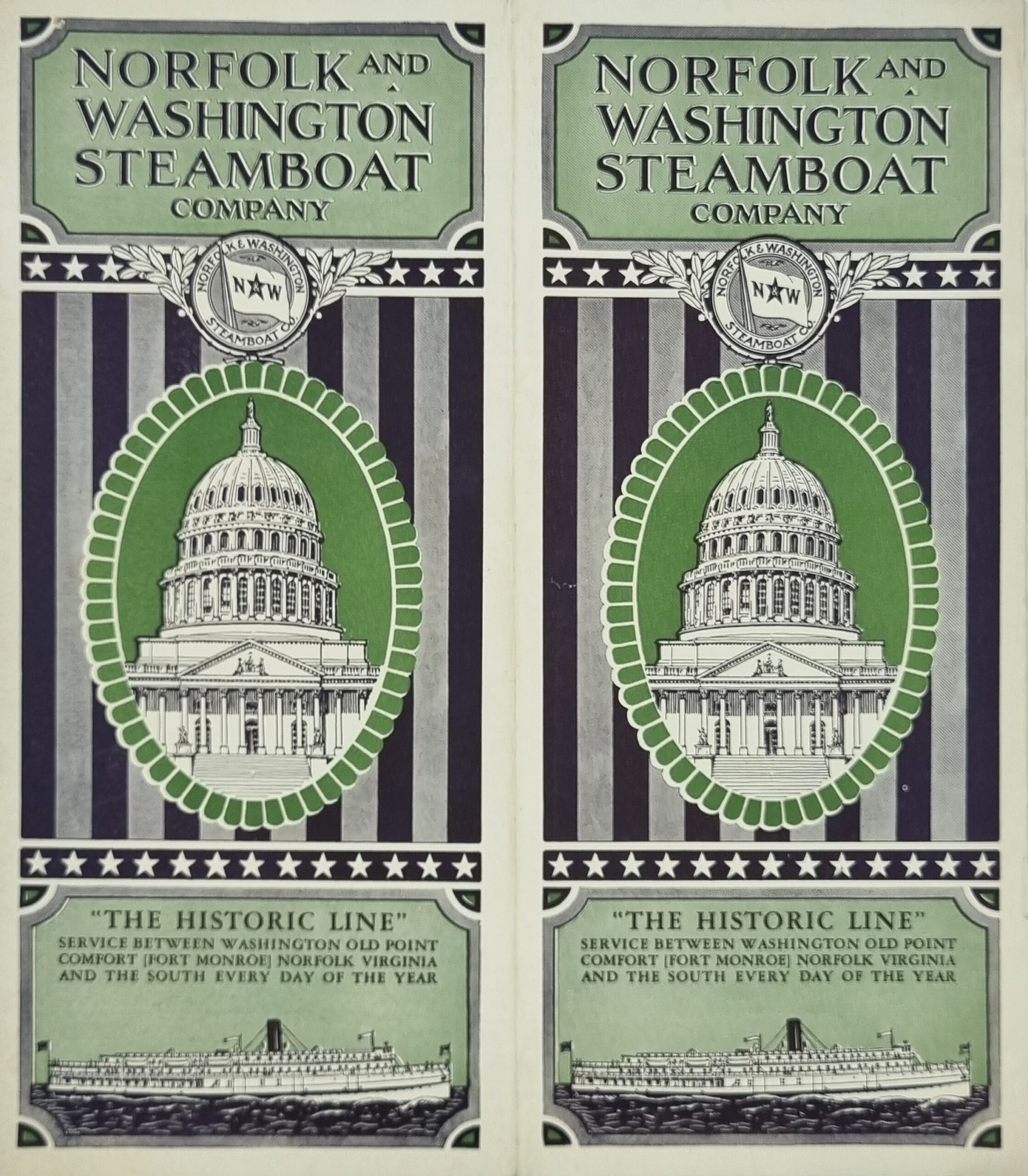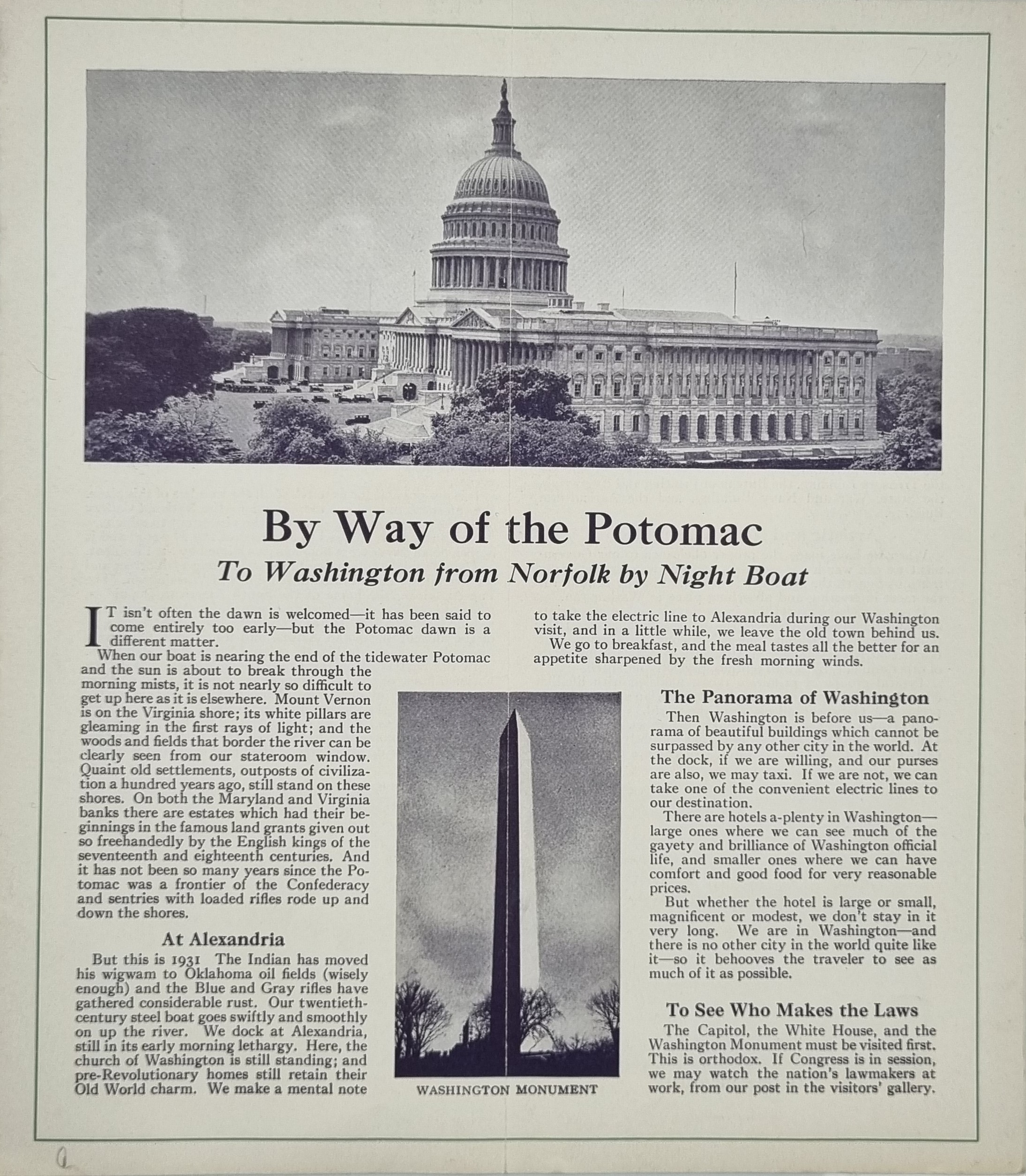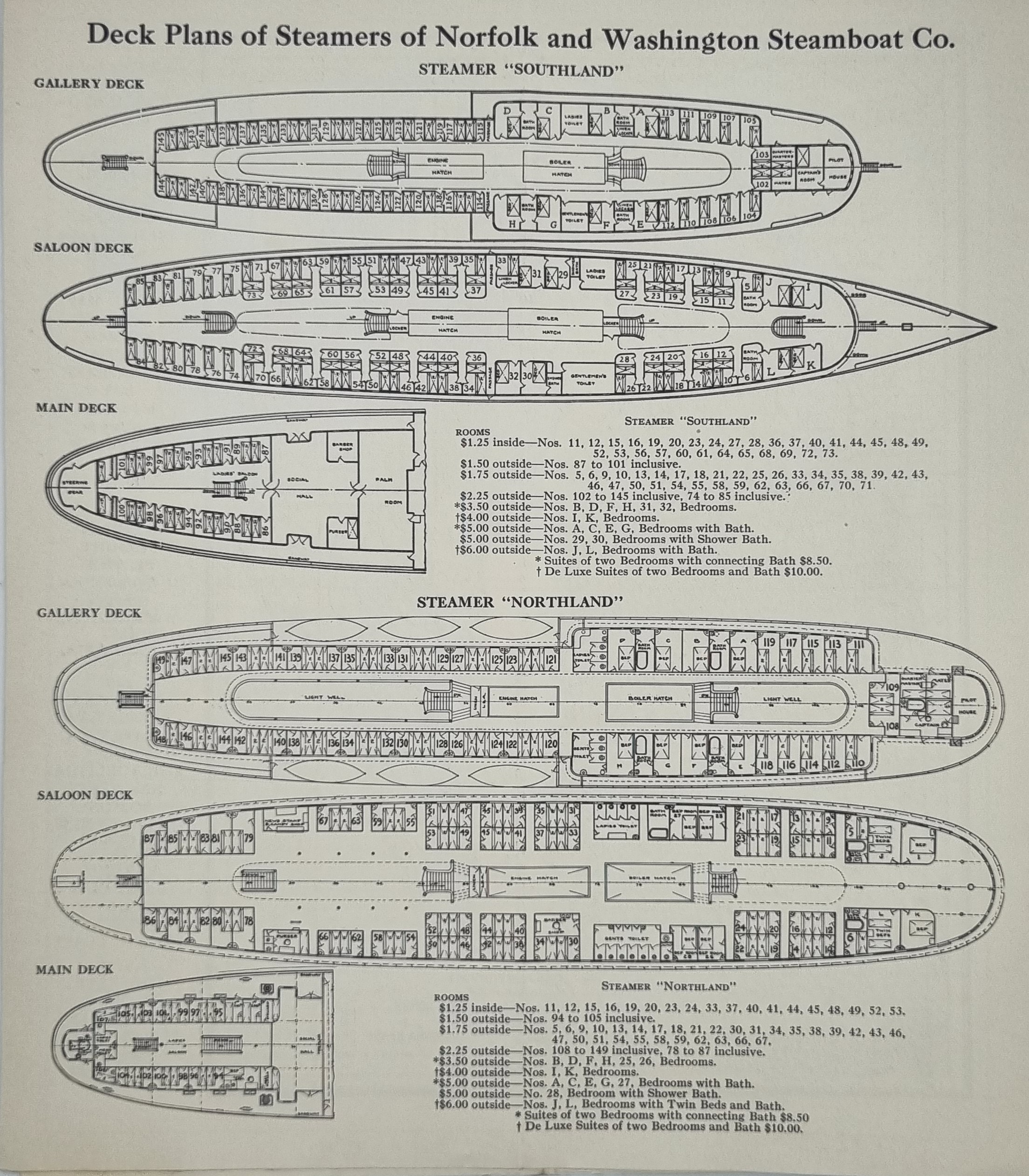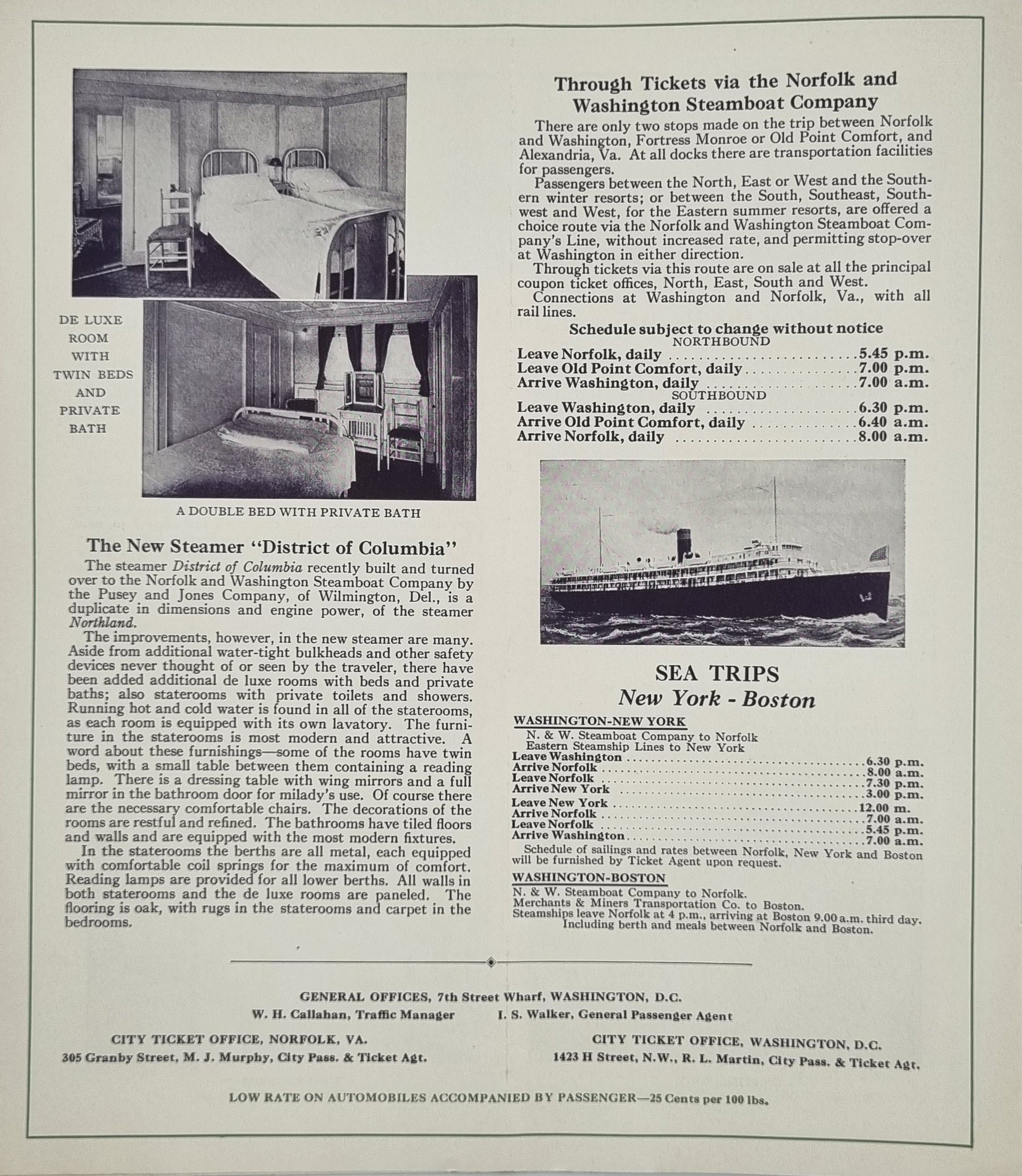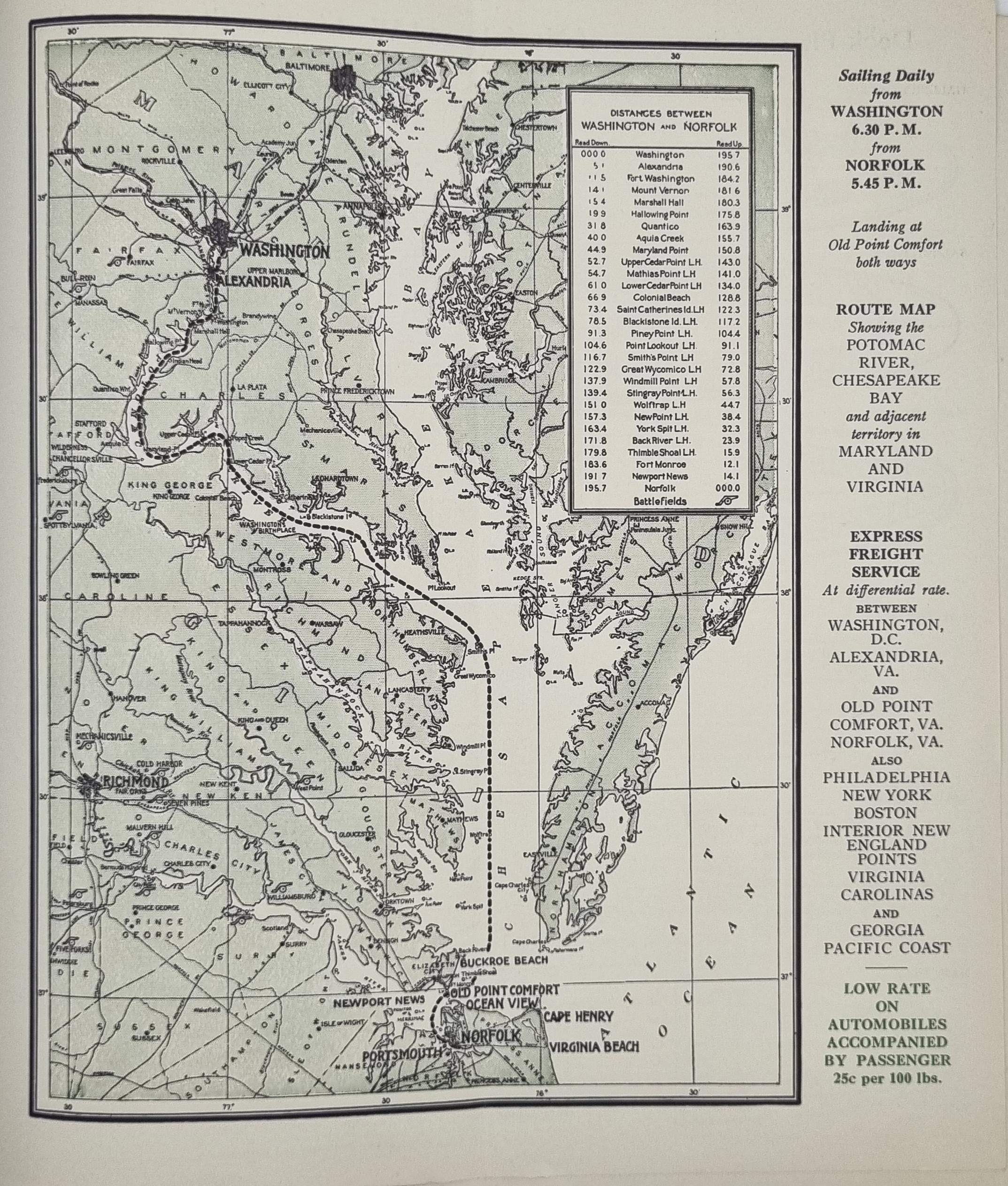The Norfolk & Washington Steamboat Company was a steamboat company that transported passengers and freight between Washington, DC and Norfolk, Virginia on the Potomac River.
The company was organized in the Spring of 1889 and charter in 1890 with the capital largely coming from Washingtonians. A bill was introduced on January 4, 1890 for incorporation in the Virginia State Senate. The object of the company was to equip and operate a line of steamers for the transport of passengers and freight between Washington, DC and Norfolk, Virginia on the Potomac River. The capital stock was to be no less than $100,000 and an option for a railroad to be built inland was introduced. The Company was to build four first-class powerful steamers with all modern improvements according to the incorporation bill. They would run from Washington, DC to Norfolk with stops in Alexandria at Old Point and Newport News. The original Commissioners were Chas. C. Duncanson, John Callahan and Levi Woodbury.
In 1890, the company started operating with a sidewheeler named the George Leary. It operated from Washington to Norfolk with stops in Alexandria and Old Point Comfort. Two additional boats were specially ordered to run the line at night. Two other boats were to be built if the business need arose to have day trips. These boats would be known as the Washington and the Norfolk.
Its first steamer of the fleet that was to be nicknamed the Potomac Palaces was the Washington. It named after one of the ports being serviced by the company and was launched on November 22, 1890 in Wilmington, Delaware. Manufactured by Harlan and Hollingsworth, it was launched at 9 am on that day in the presence of several members of the company who had travelled to the city for the occasion. It was christened by Miss Jane McCoy, aged 12 years old and daughter of Dr. McCoy of Philadelphia. It measured 258 feet in length with a width of 46 feet and a depth of 23 feet. It was made of iron and double-plated from the front to mid-ship at the waterline to allow it to cut through the ice that could form in the area. Six bulk heads divided the ship and offered additional protection in case of a leak occurring in a compartment. It was driven by a screw propeller of 13 1/2 in diameter with triple expansion engines of 2,000 horsepower and 14 feet boilers guaranteeing a speed of 17 miles per hour.
The saloon deck extended the entire length of the ship. It had forty bedrooms and eight double state-rooms. The interior was decorated and panelled and the main colors were white and gold. The Officer’s quarters had a gallery containing twelve bedrooms with an inside stairway connecting it to the saloon. The staterooms and the main stairways were finished in quartered oak while the dining room was made of maple and could accommodate 60 people. The kitchen with its pantry and refrigeration and steward’s room were equipped with the latest standard in appliances at the time. The main deck had 22 staterooms, a social hall, a barbershop, bathroom, a purser’s office and a baggage room decorated in panelling terra-cotta, butternut and gold. The entire ship was lighted with electricity.
A trial trip was conducted on March 12, 1891 on the Delaware River and Bay from Christian’s Creek to Ledge Light and back, a distance of eighty miles. Guests including the commissioners, were on board to witness the trial and were served a luncheon by the builders. A speed test was conducted during the run resulting in the boat making a mile in three minutes and seven seconds. The steamer arrived at the DC wharf on March 26, 1891 under the command of Captain S. B. Davis who had been navigating the Potomac since 1871.
On September 29, 1890, it was recommended by Captain Rossell that a lease be approved for a wharf located next to the arsenal wall. The steamboat company had made a request a few days earlier to have a landing point in the city. The recommendation called for an annual rent of $2,500 with an allowance of $1,500 for keeping the wharf in working order. It was approved by the Commissioners.
The Norfolk after it was renamed the Concord. The second steamer of the fleet was named the Norfolk after the second port being serviced by the company and was launched on January 10, 1891 at 12:25 in Wilmington and also manufactured by Harlan and Hollingsworth as its sister ship. It was christened by Bessie Callahan, the 18-year-old of John Callahan, one of the company’s commissioner. It was built to exactly the same specification as its twin-sister, the Washington.
The Washington and the Norfolk were the only ones in Washington, DC able to navigate the Potomac when ice formed. Due to their design, they were able to crush the ice under their weight and make a channel to navigate. On February 7, 1895, while the rest of the boats had to remain docked, the steamboats were able to make the trips on time. Ice was reported to be heavy all the way to Piney Point and fields off Point Lookout.
The line operated with two boats from 1891 to 1894. On September 13, 1894, the Alexandria Gazette reported that the Mayor of Alexandria, Henry Strauss, addressed a letter to the company informing them that its steamers were damaging the wharves as well as the small crafts docked there. They were going too fast as they passed the city as well as when they docked. Superintendent Callahan promptly acknowledged the concern and replied that he had ordered the captains to be careful and make sure no damages were done. This prompt response was probably warranted by the upcoming announcement done only two days later.
On September 15, 1894, after months of speculation, it was announced by Superintendent John Callahan, that a third steamer was to be built. The route had been a success for the company and the traffic warranted a new addition to the line. It would operate during the day and be larger and more powerful than the other two steamers while retaining their comfort. The contract was awarded to the Newport News Shipbuilding Company on November 15, 1894. The steamer would operate the day trip during the summers leaving Washington, DC at 8:30 am and arriving in Norfolk at 6:30 pm. It would be touching Alexandria, Piney Point, Point Lookout and Old Point. In the winters, she would relieve the other two ships of the company during their annual docking and overhauling.
On March 9, 1895, the District Commissioners granted a revocable permit to the Company. This permit allowed them to dredge a slip 56 feet wide, support the sides with piles to make it a steamboat berth. It was not to extend beyond he west building line of Water Street SW nor beyond the harbor line. The permit could be revoked with a 60-day notice to the company. https://en.wikipedia.org/wiki/Norfolk_%26_Washington_Steamboat_Company
Additional information
| Weight | 33 g |
|---|---|
| Dimensions | 20.5 × .05 × 23 cm |
| Author | Norfolk and Washington Steamboat Company |
|---|---|
| Publisher | Norfolk and Washington Steamboat Company |
| Published On | 1932 |
| Pages | 11 |
| Country | Washington: USA |
| Language | English |
| Dimension | 20.5cm x 23cm |
| Item Weight | 33gms |

